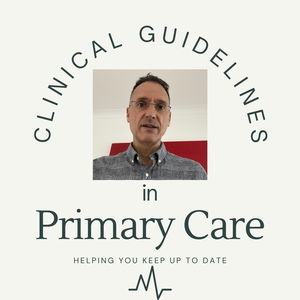

For the introductory video on cardiovascular risk reduction and lipid modification:
· https://youtu.be/jIhlkmOcsiI
For the NICE guidance on cardiac chest pain video:
· https://youtu.be/so97zARpmME
For the NICE management of stable angina video:
· https://youtu.be/BtWs0VHjp00
This episode makes reference to guidelines produced by the "National Institute for Health and Care Excellence" in the UK, also referred to as "NICE". Please note that the content on this channel reflects my professional interpretation/summary of the guidance and that I am in no way affiliated with, employed by or funded/sponsored by NICE.
My name is Fernando Florido, and I am a General Practitioner in the United Kingdom. In this episode, I review the NICE guideline “Cardiovascular disease: risk assessment and reduction, including lipid modification” [NG238], published on 14 December 2023, focusing on what is relevant in Primary Care only. I cover CV risk assessment, recommendations for specialist referral and considerations before starting statin therapy. In the next episode I will cover the rest of the guideline including primary and secondary prevention, assessing response to treatment, optimising therapy and what to do when statins are contraindicated or not tolerated.
For a refresher on the NICE guidance on cardiac chest pain and the management of stable angina, please refer to the corresponding episodes on this channel. The links are shown above.
I am not giving medical advice; this video is intended for health care professionals; it is only my summary and my interpretation of the information consulted. You must always use your clinical judgement.
There is a YouTube version of this and other videos that you can access here:
The Practical GP YouTube Channel:
· https://youtube.com/@practicalgp?si=ecJGF5QCuMLQ6hrk
The resources consulted can be found here:
The NICE guideline “Cardiovascular disease: risk assessment and reduction, including lipid modification” [NG238] Published: 14 December 2023 can be found here:
· https://www.nice.org.uk/guidance/ng238
The online version of QRISK3 can be found here:
The QRISK3-lifetime tool can be found here:
· https://qrisk.org/lifetime/index.php
The NICE guideline on familial hypercholesterolaemia can be found here:
· https://www.nice.org.uk/guidance/cg71
The Simon Broome criteria for the diagnosis of familial hypercholesterolaemia can be found here:
· https://www.nice.org.uk/guidance/cg71/evidence/full-guideline-appendix-f-pdf-241917811
The Dutch Lipid Clinic Network (DLCN) criteria for the diagnosis of familial hypercholesterolaemia can be found here:
· https://www.mdcalc.com/calc/3818/dutch-criteria-familial-hypercholesterolemia-fh
Intro / outro music: Track: Halfway Through — Broke In Summer [Audio Library Release]
- Music provided by Audio Library Plus
- Watch: https://youtu.be/aBGk6aJM3IU
- Free Download / Stream: https://alplus.io/halfway-through
Transcript
If you're listening to this podcast on YouTube, for a better experience, switch to the video version. The link is in the top right corner of the video and in the episode description.
Hello and welcome, I’m Fernando, a GP in the UK. Today, we’ll look at the NICE guideline on cardiovascular risk reduction and lipid modification, or NG238, which was published in December 2023, focusing on what is relevant in Primary Care only. In this episode we are going to cover CV risk assessment, recommendations for specialist referral and considerations before starting statin therapy. Stay tuned because in the next episode we will cover the rest of the guideline including primary and secondary prevention, assessing response to treatment, optimising therapy and what to do when statins are contraindicated or not tolerated.
If you’d like a refresher on the NICE guidance on cardiac chest pain and the management of stable angina, please refer to the corresponding episodes on this channel. The links are also in the episode description.
Right, let’s jump into it.
For people without established cardiovascular disease, we are now advised to use QRISK3 instead of QRISK2 to calculate the CV risk within the next 10 years. We will do this for those aged between 25 and 84, including those with type 2 diabetes.
Because QRISK2 is currently embedded in the electronic clinical systems that most of us use in the UK, NICE accepts that, until the clinical software systems are updated with QRISK3, it may be necessary to continue using QRISK2.
However, when assessing the CV risk for people taking steroids or atypical antipsychotics or people with SLE, migraine, erectile dysfunction or severe mental illness, we are advised to use the online version of QRISK3, because QRISK2 does not take these risk factors into account and may underestimate the risk. A link to the online version of QRISK3 is in the episode description.
So, what is the difference between QRISK2 and QRISK3?
Well, QRISK3 was introduced in 2017 as an update to QRISK2 and it includes all the factors in QRISK2, but adds new risk factors to make it more accurate. These factors are:
- Some medications which are known to increase CVD risk such as:
- Atypical antipsychotics and
- Corticosteroid
- Some diagnoses which have been linked to increased cardiovascular risk, such as:
- Chronic inflammatory conditions (for example, SLE)
- Severe mental illness (understood as a diagnosis of schizophrenia, bipolar disorder or other psychoses)
- Migraine and
- Erectile dysfunction
- And examination findings such as considering systolic blood pressure variability, because fluctuations in blood pressure have been found to be an independent risk factor for cardiovascular disease. This means that even if someone’s average blood pressure is normal, large swings in systolic pressure over time can increase the CV risk.
Is there anyone that is not suitable for the QRISK3 assessment tool? Well, we should not use it for those who are already at high risk of CVD, including people with:
- Pre-existing cardiovascular disease, that is, secondary prevention
- familial hypercholesterolaemia
- type 1 diabetes
- CKD, that is, either an eGFR less than 60 ml per minute per 1.73 m2 and/or albuminuria and finally
- Those aged 85 and older. As we know, we are advised to use QRISK3 in people aged 25 to 84 so we should not assess QRISK3 for those aged 85 or older, but instead, we should consider them to be at increased risk of CVD because of age alone.
In addition, there are certain CV risk factors that are not fully considered in the assessment tools, like, for example, people treated for HIV or with drugs that can cause dyslipidaemia, such as, for example, immunosuppressants.
Although we should offer patients information about their CV risk within the next 10 years, we should also consider using a lifetime risk tool such as QRISK3-lifetime to inform discussions and to motivate lifestyle changes, particularly for people with a 10‑year QRISK3 score less than 10%, and people under 40 who have CVD risk factors. The link to the QRISK3-lifetime tool is in the episode description.
It goes without saying that we will offer lifestyle advice for both the primary and secondary prevention of cardiovascular disease in the form of:
· Healthy eating
· A cardioprotective diet where saturated fats are replaced by mono‑unsaturated and polyunsaturated fats.
· Increased physical activity
· Weight management and
· Smoking cessation and alcohol advice
But we will not recommend either:
· Aspirin for primary prevention of cardiovascular disease or
· Plant stanols and sterols in any situation
Right, so now that we know who we are going to target and how we are going to assess them, let’s see how to interpret the results.
For the initial lipid measurement, we should check a full lipid profile, measuring both total and HDL cholesterol as well as triglycerides. And, depending on the results, there will situations where we should refer patients to a lipid clinic.
So, let’s have a look at the referral recommendations.
But, before making a referral, we should exclude and manage possible secondary causes of dyslipidaemia such as, for example, excess alcohol, uncontrolled diabetes, hypothyroidism, liver disease and nephrotic syndrome.
Right, once we have excluded secondary causes, we will need to refer the patient primarily for two reasons:
1. Because of suspected familial hypercholesterolaemia or
2. Because of significantly raised triglycerides
Let’s look at familial hypercholesterolaemia first.
In order to judge the likelihood of a familial lipid disorder, we are advised to consider clinical findings, a full lipid profile and family history, rather than using strict lipid cut-off values alone. I have put the link to the guideline on familial hypercholesterolaemia in the episode description but, in summary, we should suspect it if:
- the total cholesterol is greater than 7.5 mmol/l or
- there is a personal or family history of premature coronary heart disease (that is, an event before 60 years in an index individual or first-degree relative).
To diagnose familial hypercholesterolaemia in Primary Care, we will need to use the Simon Broome criteria or the Dutch Lipid Clinic Network (DLCN) criteria and apply them to those whom we suspect to have the condition. This should be done by someone competent in using the criteria, so we should seek advice if necessary. I have put links to the criteria in the episode description. If the criteria are met, we will make a clinical diagnosis of familial hypercholesterolaemia and we will refer them accordingly for consideration of genetic testing and family screening.
However, NICE recommends direct specialist referral without having to apply these criteria if
· total blood cholesterol is more than 9.0 mmol per litre or
· non-HDL cholesterol is more than 7.5 mmol per litre
and this is even in the absence of a first-degree family history of premature coronary heart disease.
Let’s now look at when to refer when triglycerides are significantly raised.
For those with triglycerides of more than 20 mmol per litre that is not a result of excess alcohol intake or poor glycaemic control, we will refer them for urgent specialist review. This is because such elevated levels increase the risk of acute pancreatitis.
For those with triglycerides between 10 mmol and 20 mmol per litre:
- we will repeat the triglycerides with a fasting test (after an interval of 5 days, but within 2 weeks) and
- we will refer if the triglyceride level remains at more than 10 mmol per litre and secondary causes have been excluded
Those with triglycerides between 4.5 mmol and 9.9 mmol per litre do not necessarily need referral but we need to be aware that QRISK may underestimate the CV risk in these cases.
Right, let’s assume that the patient has a high CV risk. The main way to reduce the CV risk in both primary and secondary prevention is with statins. What general information should we give to patients before starting them?
We should advise that the risk of muscle pain, tenderness or weakness associated with statin use is small and the rate of severe muscle adverse effects (or rhabdomyolysis) because of statins is extremely low.
We should also advise that:
- other drugs, some foods (for example, grapefruit juice) and some supplements may interfere with statins and
- they should always check the risk of interactions when starting other drugs or thinking about taking supplements.
Next, before starting statins we should:
Assess the patient, including smoking, alcohol, BP and BMI and
Perform blood tests including:
- a full lipid profile
- fasting glucose or HbA1c
- renal and liver function tests and
- thyroid function tests including TSH for those with symptoms of underactive or overactive thyroid.
We will not routinely exclude from statin treatment people who have high liver transaminase levels which are less than 3 times the upper limit of normal.
Also, before offering a statin, we should ask if they have had persistent generalised unexplained muscle symptoms (like pain, tenderness or weakness), and, if so, we will measure creatine kinase levels. If creatine kinase levels are:
- more than 5 times the upper limit of normal, we will recheck it after 7 days and if still 5 times the upper limit of normal, we will not start statin therapy. However, if CK levels are
- raised but less than 5 times the upper limit of normal, we can start statin treatment but we will do so at a lower dose.
We obviously need to be aware that statins are contraindicated in pregnancy and that:
- statins should be stopped if pregnancy is a possibility
- statins should be stopped 3 months before attempting to conceive
- statins should not be restarted until breastfeeding is finished.
And that is it, an introduction to CVD risk reduction in primary care. Make sure not to miss the next episode where we will cover the rest of the guideline including statins for both primary and secondary prevention.
As always, remember that this is not medical advice, but only my summary and my interpretation of the guidelines. You must always use your clinical judgement.
Thank you for listening and goodbye.
Senast besökta

Primary Care Guidelines

Talkin' Ball with Pat Leonard

Cristina Yang, Please Return Our Calls: An Improvised Grey's Anatomy Podcast

The Shawn Bolz Show

Slow Drag with Remedy :: An Elvis Costello Appreciation

Die Friedliche Geburt – Wissen & mentale Stärke für deine Geburt

Step Out of the Shadows and Speak!

80sography - 80s music interviews

The Shakespeare and Company Interview









